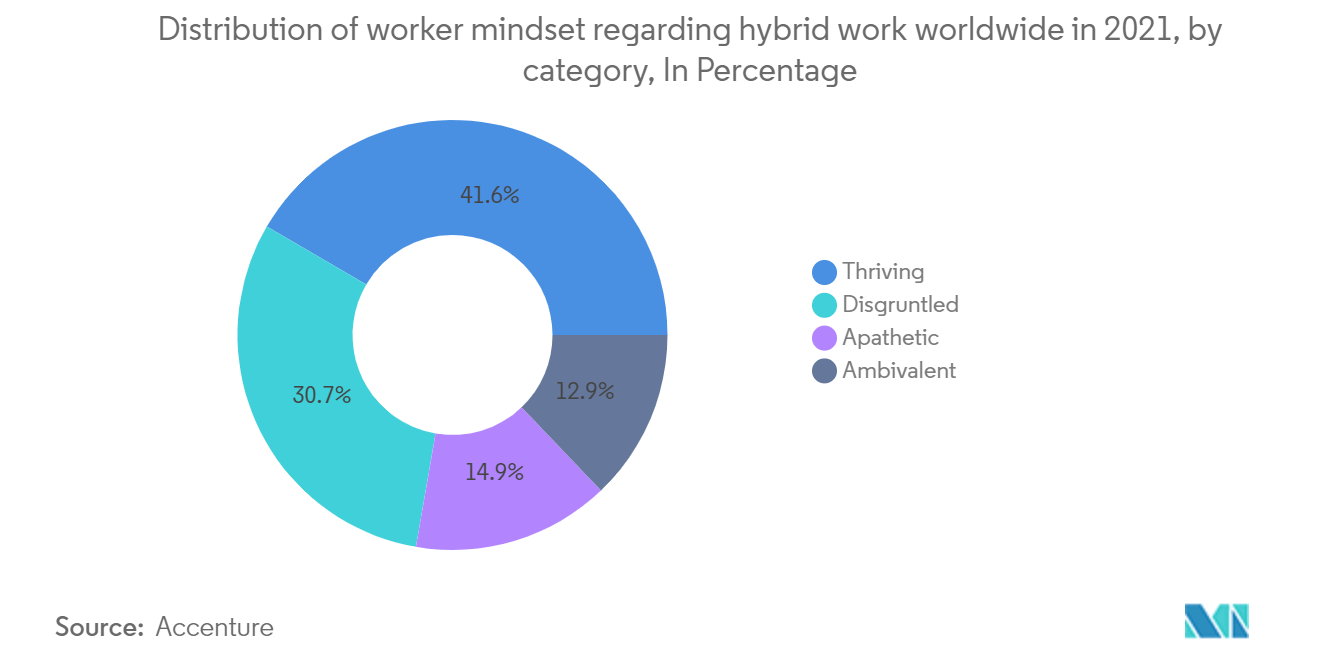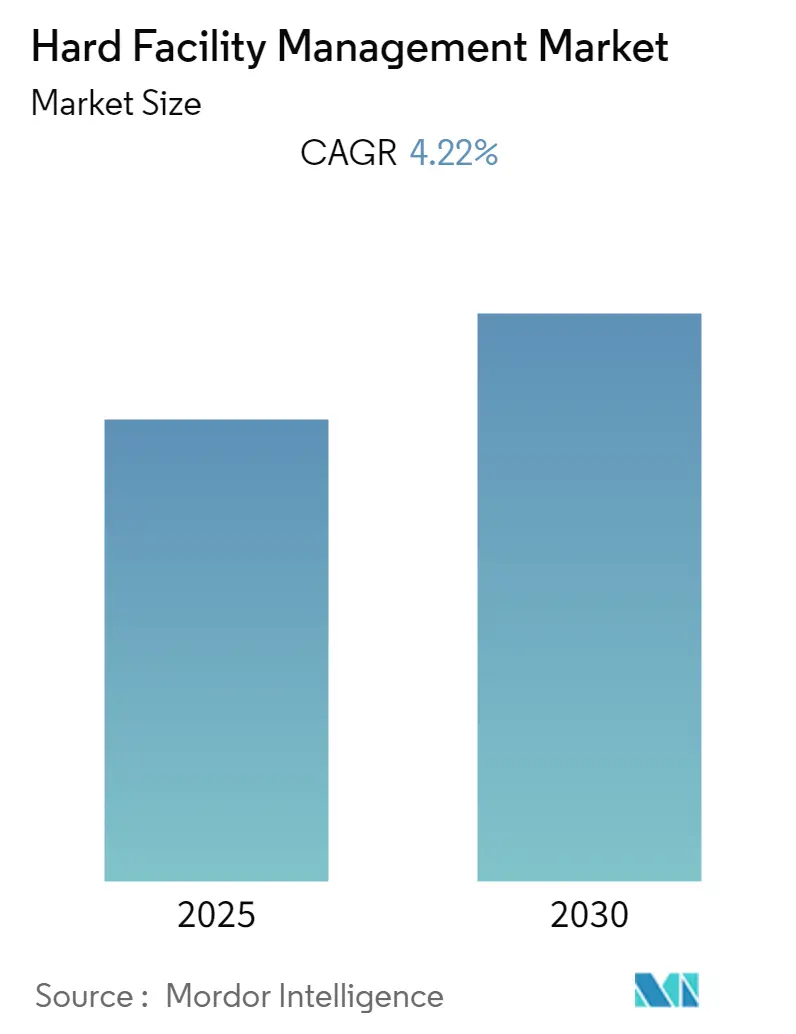
| Study Period | 2019 - 2030 |
| Base Year For Estimation | 2024 |
| Forecast Data Period | 2025 - 2030 |
| Historical Data Period | 2019 - 2023 |
| CAGR | 4.22 % |
| Largest Market | Asia-Pacific |
| Market Concentration | Low |
Major Players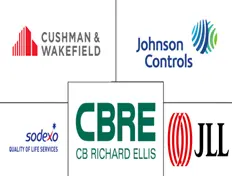
*Disclaimer: Major Players sorted in no particular order |
Hard Facility Management Market Analysis
The Hard Facility Management Market is expected to register a CAGR of 4.22% during the forecast period.
- Due to the increase in infrastructure-related activities, particularly in developing nations like China and India, the hard services category is expected to grow during the forecast period. The demand for hard services like heating, ventilation, and air conditioning (HVAC) and mechanical and electrical maintenance has increased due to the increase in infrastructure-related activities. The real estate sector is expected to witness strong growth on the back of increased commercial and infrastructural development and remodeling efforts across the globe.
- Enterprise asset management (EAM), refers to the administration of an organization's physical assets throughout each asset's life cycle. EAM solutions offer asset health information and day-to-day administration, which is crucial for businesses that depend on vital infrastructure assets to sustain their customers and satisfy business and regulatory objectives. Enterprises across the words are investing huge sums of money in EAM.
- Both before and after the pandemic, HFM services have experienced faster growth than entire economies, despite significant entry barriers. This demonstrates the vitality of these professions and the ease with which employers can fill job positions in them (as opposed to soft services), thanks to both higher pay rates and the higher switching costs entailed by these highly specialized skill sets.
- The current state of the labor market is one of the main problems for the sector. The HFM sector needs qualified, partially qualified, and unskilled workers. More professionals still need to manage large-scale infrastructure projects, particularly in the technical services sector. As a result, keeping up with the industry's rapid growth is difficult because most professionals still need extensive training and time to understand their roles thoroughly. Retaining labor is also an issue because unskilled laborers are prone to changing employment.
- After the restrictions related to the pandemic ended, returning to the workplace was made possible. Due to more rigorous hygiene standards in the workplace, there has been an increased need for facility management services in recent years. Owing to the application of social distancing guidelines, many HFMs had to redesign office layouts compulsorily, spacing desks apart and installing screen barriers to prevent too close contact. For the upcoming several months, all sectors of complex facility management are expected to witness a considerable demand surge.
Hard Facility Management Market Trends
Robust Post-COVID Demand for HFM
- The COVID-19 pandemic has altered some aspects of our daily routines. However, it also allowed several sectors, like hard facilities management, to help reduce the spread. In a post-covid environment, there is more awareness of several areas, including cleaning, maintenance administration, and ventilation. Facilities management services take care of these issues, ensuring that organizations continue to run smoothly, hygienically, and securely.
- Cleanliness being the basic concern, technology is crucial to reducing the spread of COVID-19 and other airborne infections. The rising attention of facility management services towards cleanliness emphasizes the necessity of using contactless solutions across several sectors. Staff and visitors would feel safer at work if contactless entrance and exit points were included, such as QR codes for access control and door activation. Contactless payments are another approach to keep consumers and staff feeling safe, for instance, in the retail sector. Such technology would improve businesses' energy efficiency while also reducing unnecessary touch.
- Facility management can assist in ensuring that air quality in buildings remains a top priority in the post-COVID era. All air movement systems and equipment must be kept in good working order. Employee productivity may be raised, and health hazards decreased in the workplace by maintaining a suitable temperature and lowering humidity. Regular HVAC system maintenance can help with this. For instance, your company could stay on top of removing indoor air pollutants to provide fresh air in the workplace by utilizing a planned maintenance routine.
- Establishing a work atmosphere that encourages addressing current thoughts is essential. This calls for unique seating configurations and space layout that goes beyond the conventional cubicle concept. Even if the government has loosened social distancing regulations, many workers still feel more at ease knowing that workstations are appropriately spaced apart. As a result, many companies move to open plans in the post-covid era. Additionally, open office spaces are advantageous for better ventilation, which raises indoor air quality.
- With the emergence of a hybrid work culture, getting the work done is much more important than it is being done. Therefore, facility managers ensure that employees have a consistent experience, whether working in an office or remotely. According to a report published by Accenture, 42% of employees expect hybrid work to succeed in the last year. This highlights the fact that over half of the global workforce has an optimistic outlook on the future of work. Notably, 31% of those surveyed said they were displeased by this situation.
Significant Use of Enterprise Asset Management (EAM)
- Organizations may greatly benefit from enterprise asset management since it aids in planning, optimizing, executing, and tracking all maintenance tasks by priorities, tools, materials, costs, skills, and various sorts of information. The market for enterprise asset management is anticipated to expand strongly in the following years because of the technology's ability to enhance asset performance and promote industry or business expansion.
- Applications for facilities management and EAM are aimed at global companies of all sizes and sectors. From the moment that various physical assets, including buildings, equipment, vehicles, and machinery, are purchased until they are disposed of, they are managed using tools and processes made available through the enterprise asset management system.
- EAM is primarily used by businesses that want to maximize the use of their physical assets throughout their entire asset lifespan, thereby causing the demand for EAM to grow rapidly across the world. EAM helps to maximize the effectiveness and efficiency of resources throughout their lifecycles, boost productivity, and save operating expenses. The combination of software and service aids in managing the operational resources and machinery of large businesses.
- Top-level enterprises are currently using EAM to boost their businesses' bottom line and give them a clear understanding of the future of the business's physical assets. With the help of EAM, it is possible to gain insights into load distribution and operational capacity utilization of any machine and increase productivity by regularly using agile asset management systems. Also, most large enterprises are implementing EAM to have a properly streamlined asset life cycle process that helps them make the right decisions regarding their physical assets at the right time.
- The value of all the assets managed in North America in 2021 exceeded the sum of the values of the assets managed in Europe and Asia (Japan excluded). According to BCG, in 2021, North America assets under management (AUM) assets under management (AUM) in North America reached USD 54 trillion, or about half of the entire AUM globally.
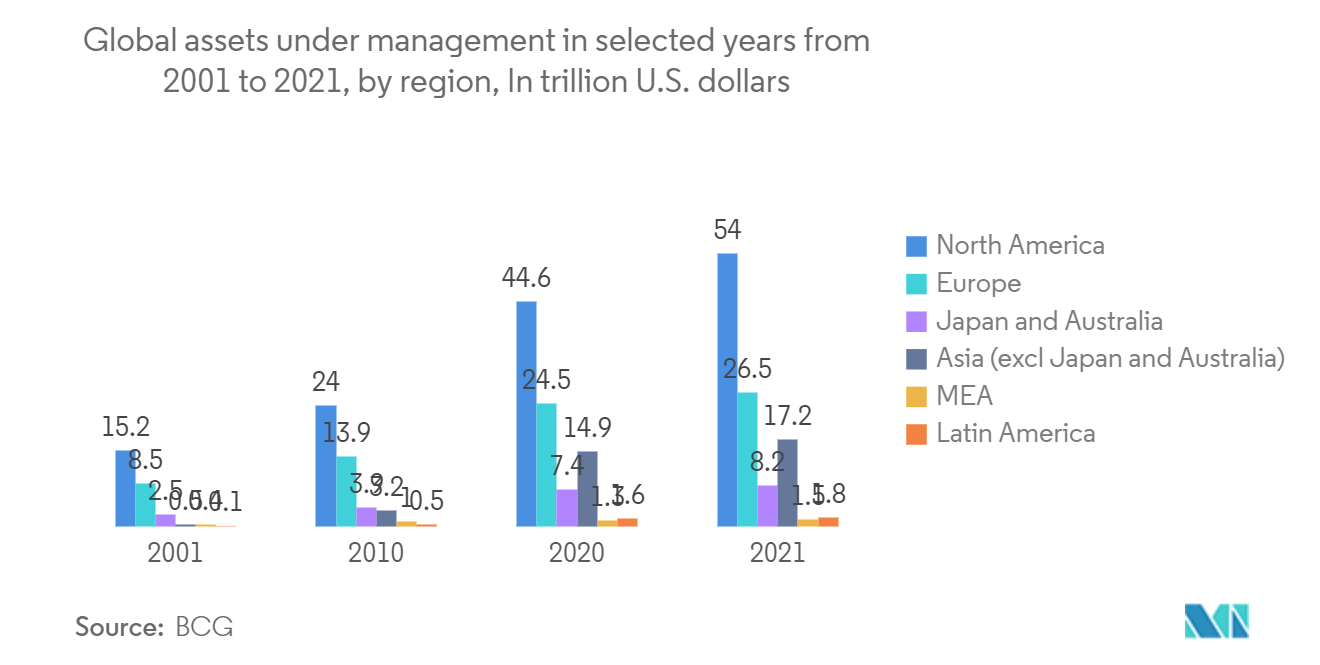
Hard Facility Management Industry Overview
The HFM market is highly fragmented, with local and international players having decades of industry experience. The HFM vendors are incorporating a powerful competitive strategy by leveraging their expertise. HFM companies are incorporating technologies into their services, strengthening their service portfolio. The major players are CB Richard Ellis (CBRE), Sodexo Facilities Management Services, Jones Lang LaSalle Incorporated, Johnson Controls International plc., and Cushman & Wakefield.
- July 2022: Johnson Controls unveiled its innovation center in Hyderabad. In a bid to expand its footprint in India, the company had unwrapped Hyderabad's OpenBlue Innovation Center. This is crucial for developing innovation in sustainable technology for building security and the state's ambitions to position itself as a center for tech innovation and talent in India.
- March 2022: Sodexo Ireland, one of the top providers of office services, launched a new partnership with Sensori Facilities Management to support customers' efforts to manage office space and work flexibly and suitably. Sodexo's experience in workplace transformation and Sensori FM's expertise in digital intelligent building solutions are both utilized in the new FM cooperation.
Hard Facility Management Market Leaders
-
CB Richard Ellis (CBRE.)
-
Sodexo Facilities Management Services
-
Jones Lang LaSalle Incorporated
-
Johnson Controls International plc.
-
Cushman & Wakefield
- *Disclaimer: Major Players sorted in no particular order
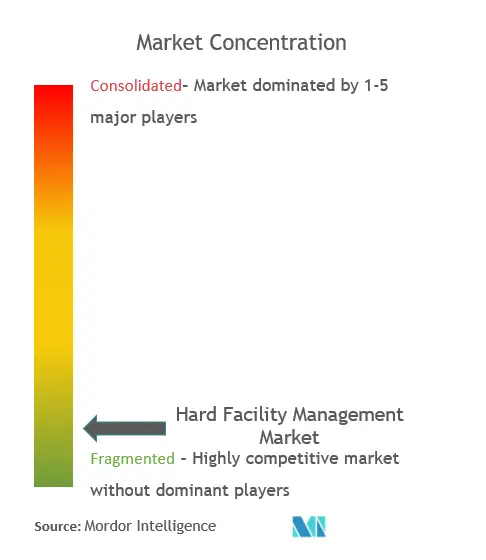
Hard Facility Management Market News
- September 2022: Sodexo India announced that it was extending its service avenues by adding employee-providing services to its portfolio. This national movement provided Sodexo with global publicity.
- August 2022: ISS AS, an international workplace experience and facilities management firm, planned to expand its India business over the next three years. Based on robust economic growth, the firm has declared ambitions to increase its employee headcount by 25 to 30% to accommodate greater activity in both the office and production-based areas.
Hard Facility Management Industry Segmentation
Hard facility management (HFM) services involve managing the people, technology, systems, and equipment that make up a company's physical structure.
The hard facility management (HFM) market is segmented by type (mechanical, electrical, plumbing (MEP) and HVAC maintenance services, and enterprise asset management), end user (commercial, institutional, public/infrastructure, industrial, and other end users), and geography (North America, Europe, Asia-Pacific, Latin America, and Middle East and Africa). The market sizes and forecasts are provided in terms of value (USD billion) for all the above segments.
| By Type | MEP (Mechanical, Electrical, Plumbing), and HVAC Maintenance services |
| Enterprise Asset Management | |
| Other Hard FM Services | |
| By End User | Commercial |
| Institutional | |
| Public/Infrastructure | |
| Industrial | |
| Other End Users | |
| By Geography | North America |
| Europe | |
| Asia-Pacific | |
| Latin America | |
| Middle East and Africa |
Hard Facility Management Market Research FAQs
What is the current Hard Facility Management Market size?
The Hard Facility Management Market is projected to register a CAGR of 4.22% during the forecast period (2025-2030)
Who are the key players in Hard Facility Management Market?
CB Richard Ellis (CBRE.), Sodexo Facilities Management Services, Jones Lang LaSalle Incorporated, Johnson Controls International plc. and Cushman & Wakefield are the major companies operating in the Hard Facility Management Market.
Which region has the biggest share in Hard Facility Management Market?
In 2025, the Asia-Pacific accounts for the largest market share in Hard Facility Management Market.
What years does this Hard Facility Management Market cover?
The report covers the Hard Facility Management Market historical market size for years: 2019, 2020, 2021, 2022, 2023 and 2024. The report also forecasts the Hard Facility Management Market size for years: 2025, 2026, 2027, 2028, 2029 and 2030.
Our Best Selling Reports
Hard Facility Management Industry Report
Statistics for the 2025 Hard Facility Management market share, size and revenue growth rate, created by Mordor Intelligence™ Industry Reports. Hard Facility Management analysis includes a market forecast outlook for 2025 to 2030 and historical overview. Get a sample of this industry analysis as a free report PDF download.



